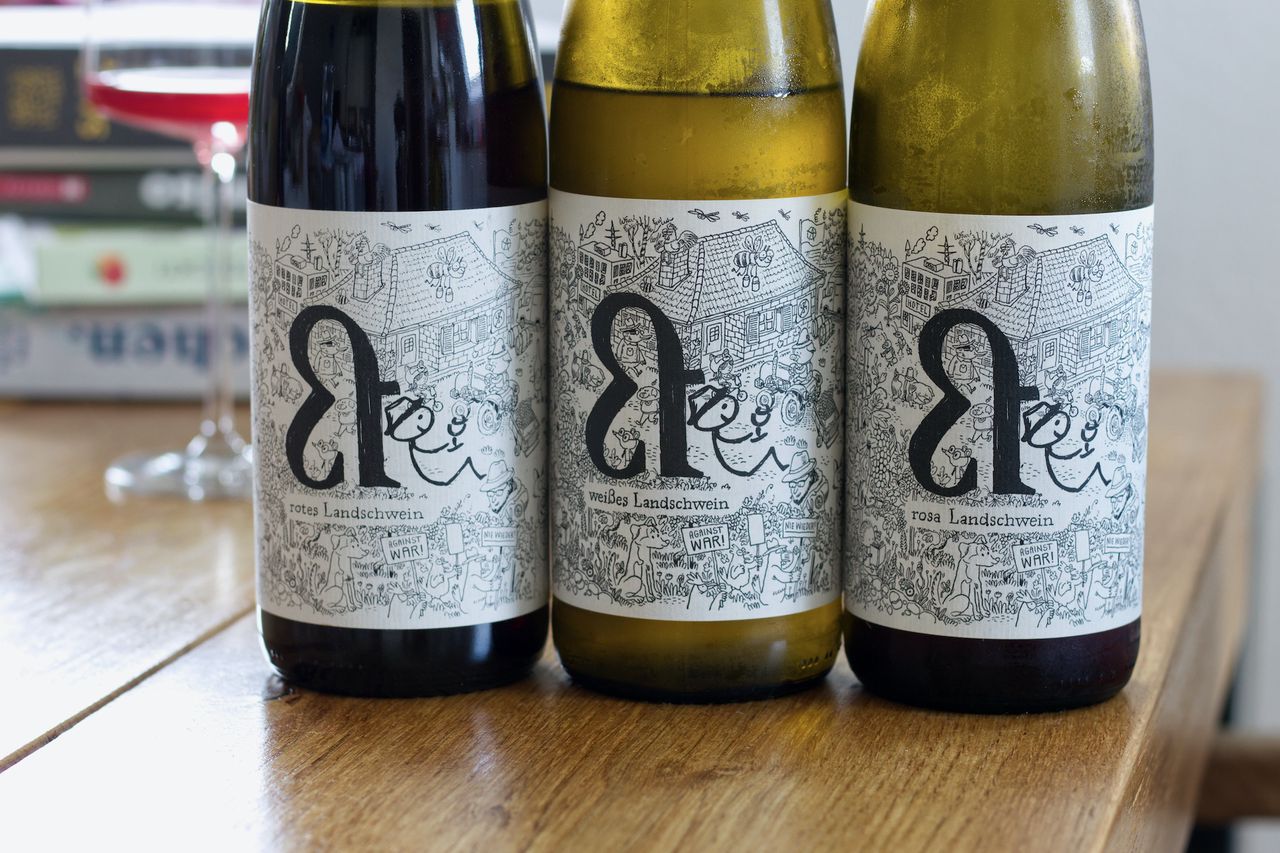Three Bottles Lukas Krauß
We drink Lukas Krauß's Landschwein in white from 2021 and in red and pink from 2020.

To be honest, I first had to consult Google about Lambsheim. The Palatinate is actually relatively often in the glass and thanks to numerous visits on site, we also know smaller villages by name. But Lambsheim is not one of them. It is located on the eastern edge in the north of the Palatinate and Lukas Krauß makes wine with a hat here. So it’s not the wine that has the hat on, but Lukas. He also keeps pigs here in addition to sheep which tend to the vineyards, so it’s not far to the Landschwein as a wine name, which means country pig in german. He fills three Landschwein wines: white, pink and red. All three wines could probably be labeled natural wine. They are fermented spontaneously, the foundation comes from the work in the vineyard, in the cellar there is as little as possible interference and the wines are not filtered and also no sulfur is added and all three are biologically produced. What all three variants also have in common, besides their great hidden-object labels, are sometimes more and sometimes less unusual grape variety blends. The white Landschwein contains Silvaner, Scheurebe and Müller-Thurgau, the pink Landschwein has Dornfelder and Blaufränkisch and the red variant consists of Dornfelder, Portugieser and Schwarzriesling. Not necessarily combinations of world renown, but that has never stopped me from tasting and at worst, in this case anyway, you can just stare at the bottle for an hour and always discover new details in the label.
We’ll start with the white Landschwein. There are herbs and exotic fruit, the Scheurebe says hello, but I wouldn’t call the wine a fruit wine. There’s also chamomile tea, some citrus and currants. The wine is super clean on the nose and extremely fresh. The acidity on the tongue then has more funk and scrapes pretty close to the border of wild. However, this suits the wine perfectly and is so lively and juicy that it is great fun to drink.
On the nose, this remains more herbal than fruity even after a night in the fridge. A bit of still too green elderflower found its way into the aroma. But now it tastes like passion fruit juice. Plus a bit of tannin that gives texture out the back. This is really tasty.
The rosé seems really tart after the white. If you drink it on its own, it’s not that noticeable, but one after the other, the contrast is enormous. There’s roasted and puffed grain on the nose mixed with a bit of red fruit. Really just a bit of fruit. This doesn’t smell like classic rosé at all, but again, there’s zero dirt on the nose. Just like in the white wine, it’s more the acidity that’s wild and gives decent juicy draw.
Here, the night actually brings a bit more funk to the wine. There’s hibiscus tea now and further the puffed grain and then some wildness after all. Also, the tannin in the mouth has picked up a good notch. Again, this is a matter of taste as to what you prefer and how much air you want to give the wine then. Personally, I would rather empty it on the first night.
The red is reminiscent of cherries on custard. There’s lactic notes and a big amount of fruit on the nose. When you put it that way, yes, sometimes it almost sounds negative to wine drinkers. I have no idea why, because fruit in wine is super and also a lot of fruit in wine can be really nice. Especially when it is as here. Not clumsy, not striking, just very, very fruity. There is also clearly acidity in the wine, which however is the tamest of all three bottles. One searches in vain for tannin on the first evening.
The tannin comes for it a day later. And as with the rosé, the whole wine becomes a bit wilder. There is still the red fruit and now also a portion of herbs. The vanilla pudding has completely disappeared. And somehow it also reminds us of healthy juice. Acerola or Goji or what people drink these days as healthy stuff. I like the wine a lot and it excells next to a simple dinner with bread, cheese and sausage.